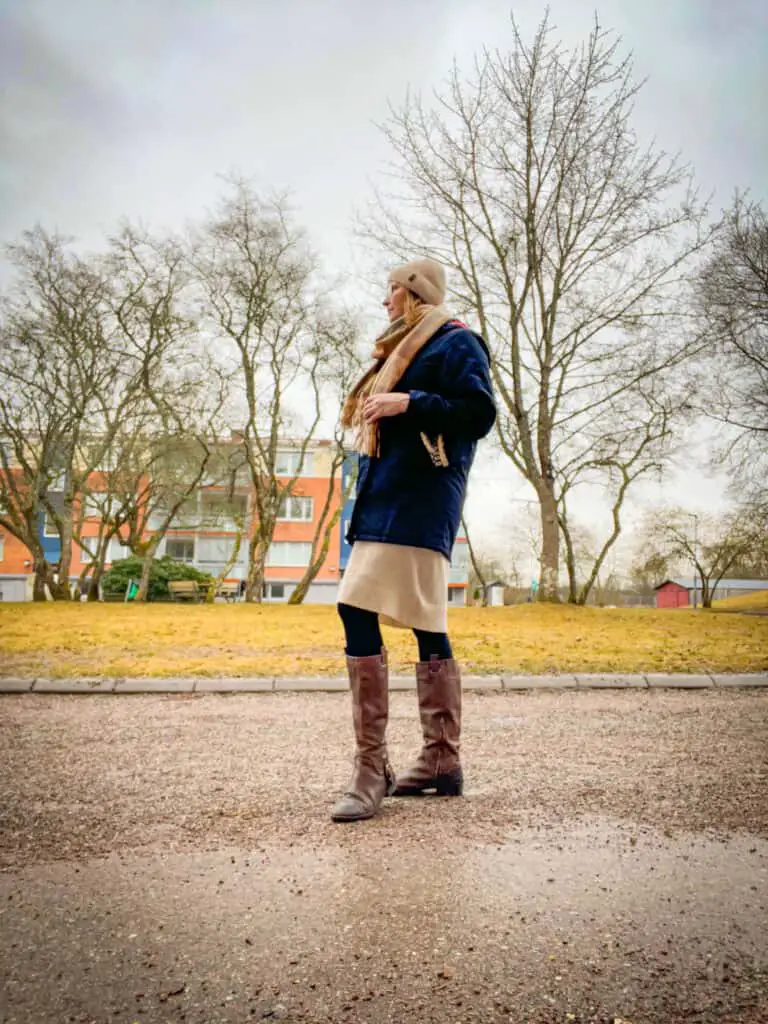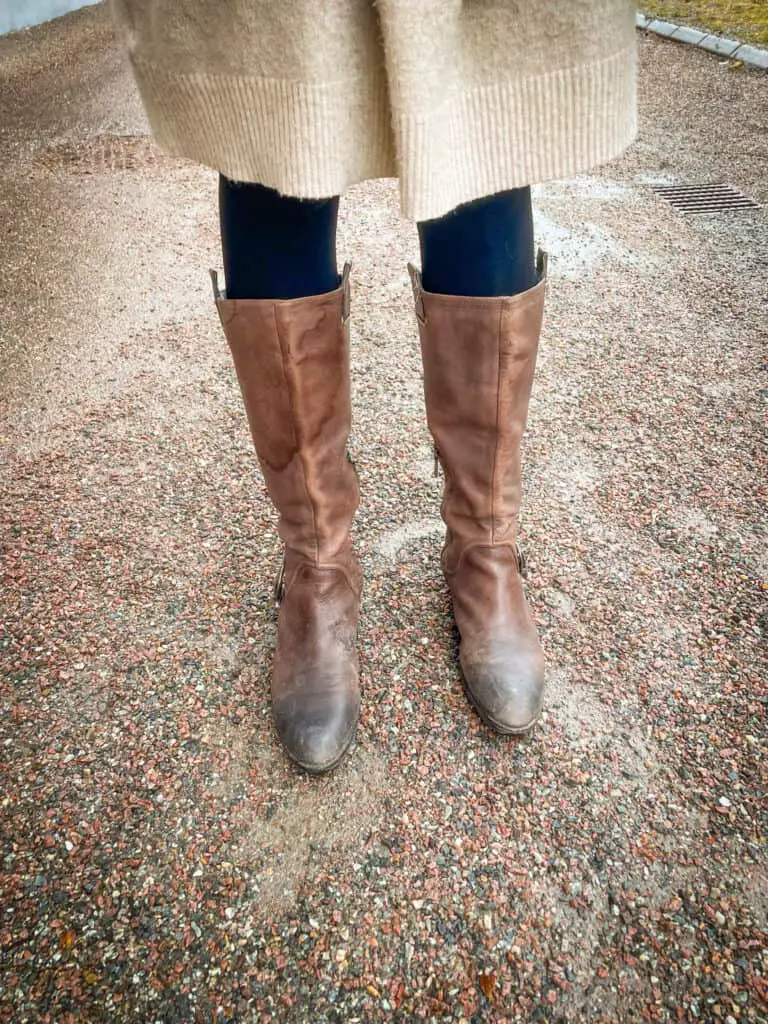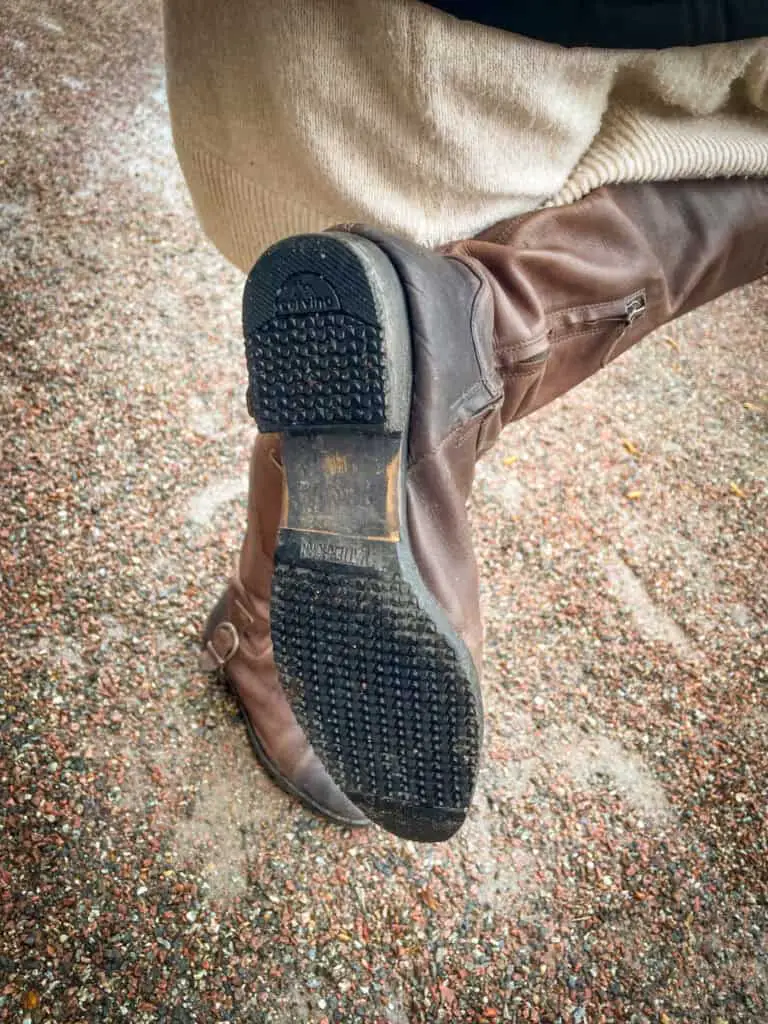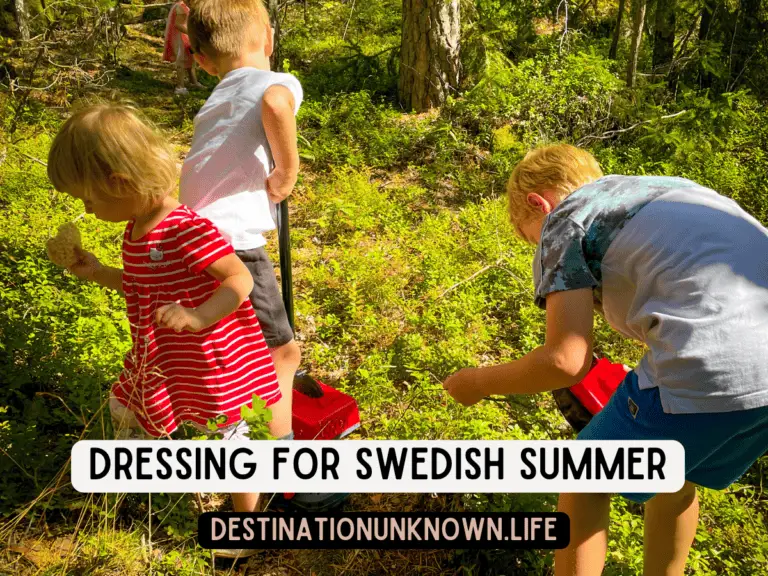Dress a family for Swedish Spring
I am sharing my top tips for dressing adults and children properly in Swedish spring, including the favorite products we wear. Our family of five relocated from tropical Florida in the Southern United States to Northern Sweden several years ago, and we were not prepared for everything we had to learn about dressing according to the seasons. The advice I share here is information that I wish I had known when we first moved here.
We wear spring clothing in Sweden in our region between March and May where temperatures regularly dip to below freezing at night, increase during the day to between 5 to 10 Celsius, and the days are a mix of sunshine and rain or snow!
We are a fairly active family, so my considerations are based on the fact that we spend time outdoors, whether walking to the grocery store or hunting for mushrooms and berries in the forest. At the bottom of this post, I share our favorite spring clothes, comfy footwear, and necessary accessories to help you survive the varying temperatures and weather conditions.
Still feeling sad from winter? Read this blog for tips on beating the winter blues in Sweden.
Build Clothing Layers for Proper Body Insulation
The number one most important thing when dressing for Swedish spring is building layers of clothing on your body. Typically, this consists of one to three layers to protect yourself as outlined below. If water (think: cold rain) penetrates your base layers, you risk hypothermia, frost bite, or worse.
The goal with layering is two-fold:
- To insulate yourself against the cold temperatures, and
- To keep yourself dry from the elements.
Build clothing layers in a Swedish winter climate
- You’ll start with base layers, preferably a wool or wool blend product, for both your top and bottom. Wool is a natural breathable product that is also water-resistant and sweat-wicking, keeping your body dry.
If you’re a person that runs warm normally, you may be able to leave these base layers off. I run cold so I feel most comfortable wearing long johns when temperatures are below 10 Celsius. - The next layer will be your normal clothes, like jeans, a long-sleeved shirt, and light-weight wool socks.
- Building on that layer should be a sweater with a high neck.
- Finally, you will put on your outerwear which protects you from the elements like snow, wind and rain. The jacket should be lighter weight than a winter coat, but still lined on the interior and have a watertight exterior. Ideally, it should also have a wind blocking element and a hood. If you’re going to be outside in the raig, then I highly recommend adding a pair of uninsulated rain pants. Of additional importance is a scarf or buff to protect your neck, an insulated hat that covers your ears and forehead, and gloves or mittens.
- Your boots should be waterproof and with a grippy, thicker sole. Early in the spring, you may still come across icy conditions, so I recommend adding slip-on ice spikes to your shoes on those days. An alternative is buying boots with ice cleats incorporated into the soles [see Ingrid’s recommendation].
- Bring a spare layer in case of accidents. Our rule of thumb is to add an extra layer, like extra gloves or hats. If you are too warm, then remove one. It’s a lot nicer than being truly uncomfortable as your body temperature plummets.



Adjust Clothing and Footwear for Colder Temperatures
Walking to the store at 10 Celsius is a different activity than running through a sporadic ice or rain storm at -10 Celsius. The clouds, rain, and sun often feel like they are fighting for space in the sky in the spring, and the weather changes rather quickly between them. Make sure you are ready for quick weather changes, so you’re not caught in the cold.
From personal experience, I realized quickly that I needed additional water protection in the form of rain pants.
 Rossignol Women's Soft Shell Lightweight Windproof Waterproof Breathable Stretch Hiking Ski Pants, Black, Medium
Rossignol Women's Soft Shell Lightweight Windproof Waterproof Breathable Stretch Hiking Ski Pants, Black, Medium
 TACVASEN Men's Water Resistant Hiking Pants All Seasons Quick Dry Working Cargo Pants Grey, 30
TACVASEN Men's Water Resistant Hiking Pants All Seasons Quick Dry Working Cargo Pants Grey, 30
 iCreek Men's Rain Pants Waterproof Over Pants Windproof Lightweight Hiking Pants Work Rain Outdoor for Golf, Fishing Black, Small/32 Inseam
iCreek Men's Rain Pants Waterproof Over Pants Windproof Lightweight Hiking Pants Work Rain Outdoor for Golf, Fishing Black, Small/32 Inseam
 Helly Hansen Women's Aden Insulated Waterproof Windproof Breathable Coat Jacket, 990 Black, 4X-Large
Helly Hansen Women's Aden Insulated Waterproof Windproof Breathable Coat Jacket, 990 Black, 4X-Large
 Potopok Winter Sheepskin Leather Gloves for Men, Warm Touchscreen Texting Gloves with Soft Cashmere Lining, Fashion Driving Gloves for Outdoor Sports(Black-M)
Potopok Winter Sheepskin Leather Gloves for Men, Warm Touchscreen Texting Gloves with Soft Cashmere Lining, Fashion Driving Gloves for Outdoor Sports(Black-M)
Protect yourself from ticks and mosquitos
As magical as it is to pick fresh berries and forage for edible mushrooms in the magical Swedish forests, it comes with some actual risks from pests and insects. Take the mosquitos, evolution’s greatest creation. They survive in all climates and everyone dislikes them, especially young kids, and they’ve ruined a few lovely trips for us in the forest. Ticks are are dangerous pest. Though you can get a vaccine for one of the diseases they carry, it doesn’t cover the other.
Instead, we try to prevent these guys all together by wearing longer sleeves and pants if we know they are bad and applying preventative spray. I’ve linked products that we’ve used in the past below or that have high-quality ingredients.
 BLUE LIZARD Sensitive Mineral Sunscreen with Zinc Oxide, SPF 50+, Water Resistant, UVA/UVB Protection with Smart Bottle Technology - Fragrance Free, 5 oz
BLUE LIZARD Sensitive Mineral Sunscreen with Zinc Oxide, SPF 50+, Water Resistant, UVA/UVB Protection with Smart Bottle Technology - Fragrance Free, 5 oz
 Sallye Ander No-Bite-Me - Repels Mosquitoes, Fleas, and Ticks - 2 oz - Organic Bug Repellent for Skin
Sallye Ander No-Bite-Me - Repels Mosquitoes, Fleas, and Ticks - 2 oz - Organic Bug Repellent for Skin
 Nantucket Spider Extra Strength Tick Repellent Spray - 2 fl oz, Pack of 3 | DEET Free, Natural Tick Repellent for Humans | Made with Organic Essential Oils |
Nantucket Spider Extra Strength Tick Repellent Spray - 2 fl oz, Pack of 3 | DEET Free, Natural Tick Repellent for Humans | Made with Organic Essential Oils |
FAQ about Dressing for Swedish Spring
What kind of warm clothes should you use in Swedish spring?
You’ll need to wear several layers of warm clothing during Swedish spring. First, wear wool or base layers on your top and bottom and medium-weight wool socks followed by a long-sleeved shirt and pants. Next, you’ll add a thick sweater and accessories like a scarf or buff, hat, and gloves. Your outer layers should include a waterproof jacket and uninsulated waterproof pants followed by thick-soled rain boots. Since this can be a rainy season, bring a spare change of clothes in case you get wet.
For young children, we recommend that they dress about the same as in winter with a one-piece insulated (waterproof) snowsuit or layer a rain jacket and rain pants over their coats and pants, to protect them from the elements.
Where do you buy spring clothes in Sweden?
Our favorite stores to shop for spring activewear clothes are Stadium and for boots are Scorett. Both of these stores have locations all over Sweden, and offer limited repair services if parts of the purchase are damaged like a zipper going off track or a small tear in a rainsuit.
Scorett works with brands like Canada Snow and Polar, both of which offer cold temperature ratings on their boots (to as low as -40 Celsius).
Conclusion to Dressing for Swedish Spring
I hope my tips for dressing adults and children properly in Swedish spring are helpful. Spring is the time of year when everything comes back to life, including tired moms.
Like I said, learning to dress properly in the northern climate took some learning and adjusting, but it’s totally doable. Certainly, it makes experiencing the beautiful season a lovely time.
If you like this Swedish content, then check out these related blogs:
- Family-friendly Activities in Sandviken, Sweden
- 1-Day Travel Itinerary to Gävle, Sweden
- Tips to Survive the Winter Blues in Sweden
- Cost of Eye Glasses in Sweden
- Cost of Preschool in Sweden
- Tips for Dressing for Swedish Winter
- Tips for Dressing for Swedish Summer
- Tips for Dressing for Swedish Fall
- Canada Snow Noel Winter Boots + Integrated Snow Cleats
Disclosure: Some of the links in this article may be affiliate links, which can provide compensation to me at no cost to you if you decide to purchase a paid plan. Thank you, if you do. As an Amazon Associate I earn from qualifying purchases. This site is not intended to provide financial advice and is for entertainment only. Read our affiliate disclosure in our privacy policy.








